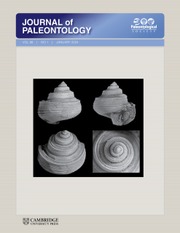Article contents
Marine Early Triassic Actinopterygii from the Candelaria Hills (Esmeralda County, Nevada, USA)
Published online by Cambridge University Press: 29 April 2019
Abstract
A new locality for low-latitudinal, Early Triassic fishes was discovered in the Candelaria Hills, southwestern Nevada (USA). The fossils are derived from the lower Candelaria Formation, which was deposited during the middle–late Dienerian (late Induan), ca. 500 ka after the Permian-Triassic boundary mass extinction event. The articulated and disarticulated Osteichthyes (bony fishes), encompassing both Actinistia (coelacanths) and Actinopterygii (ray-fins), are preserved in large, silicified concretions that also contain rare coprolites. We describe the first actinopterygians from the Candelaria Hills. The specimens are referred to Pteronisculus nevadanus new species (Turseoidae?), Ardoreosomus occidentalis new genus new species (Ptycholepidae), the stem neopterygian Candelarialepis argentus new genus new species (Parasemionotidae), and Actinopterygii indet. representing additional taxa. Ardoreosomus n. gen. resembles other ptycholepids, but differs in its more angulate hyomandibula and lack of an elongate opercular process. Candelarialepis n. gen. is one of the largest parasemionotids, distinguished by its bipartite preopercle and scale ornamentation. Presented new species belong to genera (Pteronisculus) or families (Ptycholepidae, Parasemionotidae) that radiated globally after the mass extinction, thus underlining the striking similarities between Early Triassic (pre-Spathian) osteichthyan assemblages. The current data suggest that the diversity of low-latitudinal, Early Triassic bony fishes may have been greater than indicated thus far by the fossil record, probably due to sampling or taphonomic failure. All 24 fossils from the Candelaria Hills represent mid-sized or large osteichthyans, confirming the obvious absence of very small species (≤ 10 cm adult body length) in the beginning of the Mesozoic Era—even in low latitudes.
UUID: http://zoobank.org/6a66ac96-d6b7-4617-94db-5a93cdb14215
Information
- Type
- Articles
- Information
- Copyright
- Copyright © 2019, The Paleontological Society
References
- 5
- Cited by

